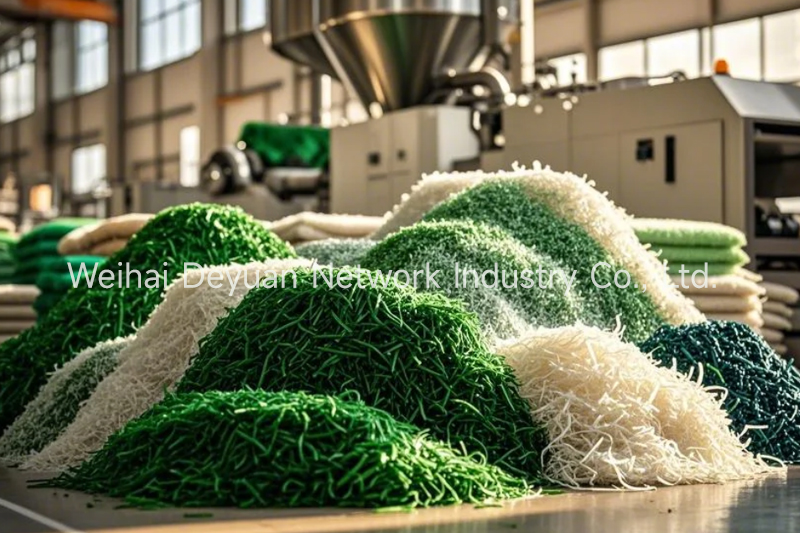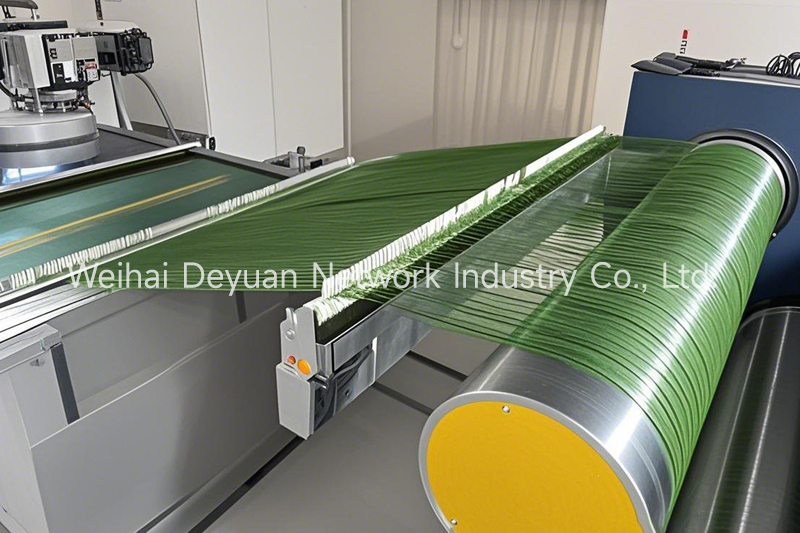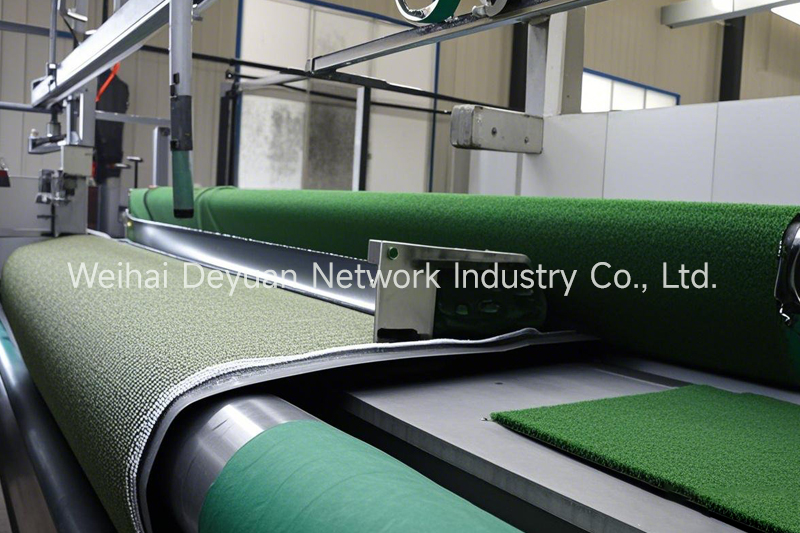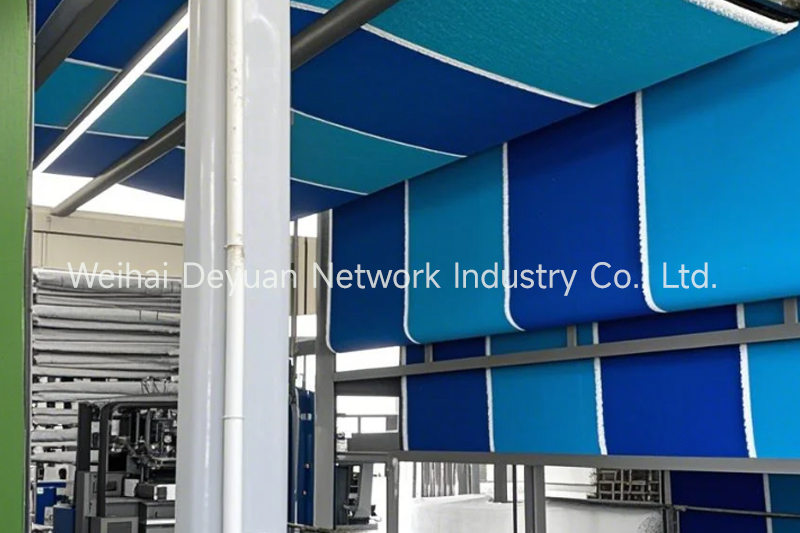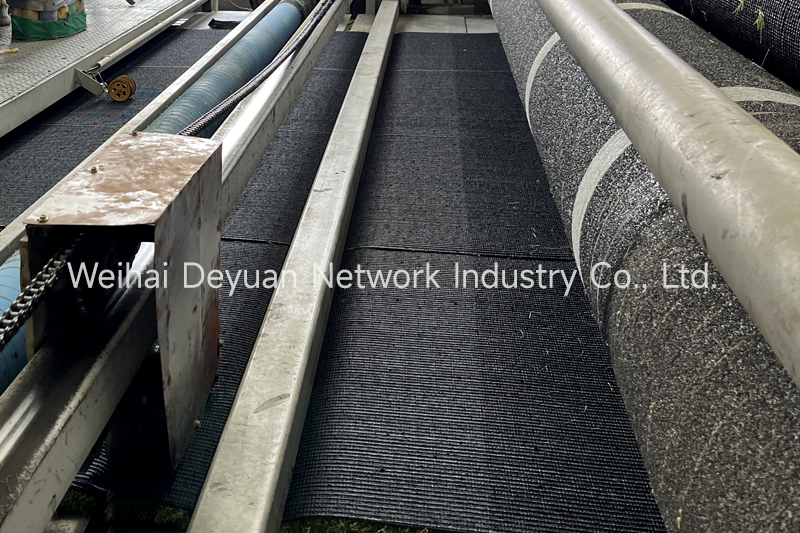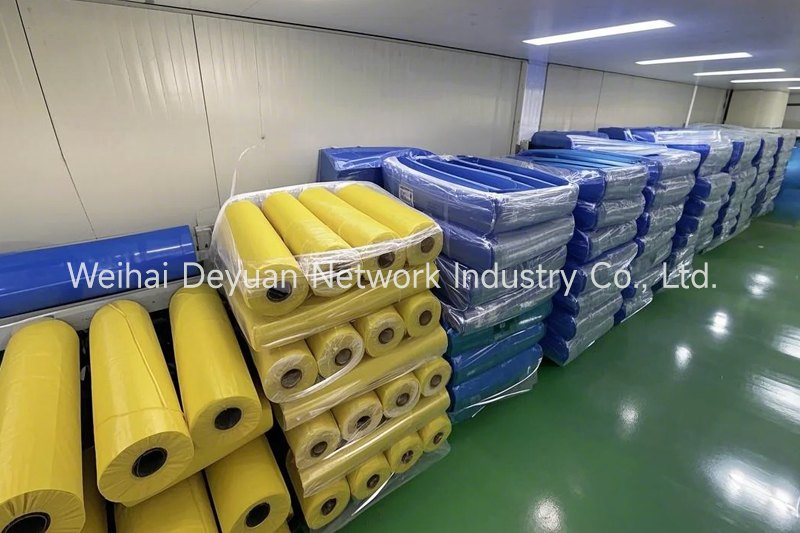1. Raw material selection and pretreatment
Grass silk raw materials
Mainly use polyethylene (PE), polypropylene (PP) or nylon (PA), and choose the material according to the purpose (such as sports lawns are mostly PE, and wear-resistant lawns are PA).
Add additives such as masterbatch, anti-ultraviolet (UV) agent, flame retardant, etc., and mix them thoroughly through a high-speed mixer.
The raw materials are dried to remove moisture (temperature 80-100℃, time 2-4 hours).
Base fabric and adhesive material
The base fabric uses polypropylene (PP) non-woven fabric or composite fabric, which must have tear resistance and corrosion resistance.
The adhesive is usually water-based polyurethane (PU) or styrene-butadiene latex (SBR), and some high-end products use environmentally friendly hot melt adhesive.
2. Extrusion and shaping of grass yarn
Melting extrusion
The mixed material is heated and melted by a screw extruder (temperature 160-220℃), and the strip grass yarn is extruded through a flat die head.
Multiple strands of grass yarn are produced simultaneously using a multi-hole die head, with a width of 0.8-1.2mm and a thickness of 0.05-0.15mm.
Stretching and curling
The grass yarn is stretched 3-5 times to enhance its longitudinal strength, and then it is elasticized by hot rollers or airflow to form a wave/spiral structure.
The wire splitter divides the grass yarn into single filaments and winds them to the spindle for standby use.
3. Tufting weaving
The base fabric is put on the machine
The base fabric is unfolded by the tension roller, and the surface is sprayed with a coupling agent (such as KH550) to improve the adhesion of the glue.
Tufting machine operation
Use a double needle bed tufting machine, with a needle speed of 400-1200 needles/minute and an adjustable row spacing of 3/8″-5/8″.
The grass yarn is implanted into the base fabric according to the preset density (6500-21000 needles/㎡), and the grass height can be customized from 10-60mm.
Real-time monitoring of needle pressure (20-50N) to avoid needle breakage, and the yarn changing system automatically connects the grass yarn.
4. Adhesive coating and curing
First coating
Apply 2-3mm thick styrene-butadiene latex (solid content 45-60%) by scraping or spraying, and penetrate the gaps of the base fabric.
Infrared pre-drying (80-100℃) removes 60% of the moisture.
Secondary reinforcement layer
Composite glass fiber mesh cloth or polyester mesh to enhance dimensional stability.
Apply polyurethane glue (thickness 1.5-2.5mm), and use double-roll reverse coating process to ensure uniform coverage.
Curing and molding
Sectional drying: initial stage 50-70℃ (20-30min), final stage 110-130℃ (15-25min).
The peel strength of the adhesive layer must be ≥35N/cm (EN standard).
5. Finishing process
Grass finishing
The fully automatic grass divider combs the sticky grass to ensure the upright rate is greater than 92%.
The circular knife shearing machine has a trimming tolerance of ±1mm, and the laser altimeter monitors in real time.
Functional treatment
Antistatic treatment: spraying quaternary ammonium salt finishing agent (resistance value ≤10^9Ω).
Cooling coating: The surface of the sports lawn is coated with a titanium dioxide/zinc oxide mixture, and the temperature difference is reduced by 3-5℃.
Quality inspection
Abrasion test (Taber method, 5000 turns of wear <5%)
Anti-aging test (QUV 2000 hours, tensile retention rate ≥80%)
Impact absorption (vertical deformation 4-9mm, in line with FIFA standards)
6. Slitting and packaging
Vertical and horizontal slitting
Double-axis air-expansion coiler for rewinding, standard roll width 4m.
High-speed circular knife slitting (accuracy ±0.5cm), automatic labeling system records batch information.
Packaging, storage and transportation
PE wrapping film + waterproof kraft paper composite packaging, ABS protective caps are installed on both ends of the roll core.
Storage needs to be protected from light and moisture (humidity ≤ 60%), and the stacking height should not exceed 5 layers.
7. Special process (optional)
3D lawn: secondary tufting to form high/low grass partitions, combined with hot pressing to shape.
Mixed grass system: a composite structure with 10-20% natural grass fiber implanted.
Smart lawn: woven conductive fiber layer, integrated temperature and humidity sensing function.
The process completely covers the manufacturing process from raw materials to finished products. All parameters are formulated in accordance with ISO 9001 and the Sports Turf Council (STC) standards, and the process combination can be adjusted according to specific application scenarios.
Post time: Feb-12-2025
